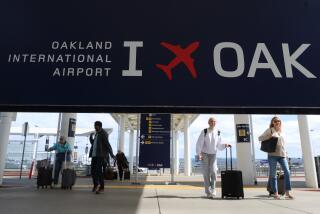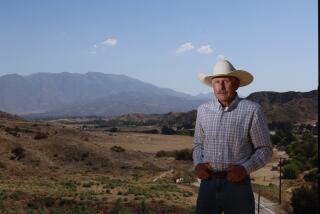Protesters Attack Proposal to Build New Terminal at Burbank Airport
Noise protesters Monday sharply attacked a proposal for a new terminal at Burbank Airport, calling it part of a plan to expand commercial air traffic.
About 20 protesters turned out for a rare night meeting of the Burbank-Glendale-Pasadena Airport Authority.
Residents east of the airport are “very upset” about recent increases in the number of flights and the prospect of still more, said Kurt Hunter, president of the North Hollywood Residents Assn.
Proposed sites for the new terminal include the airport’s northeast corner and a split-terminal plan under which automobile parking and ticket selling operations would be located in a building in the southwest corner. Passengers would travel underground to board waiting airliners from a structure in the northwest sector.
The Federal Aviation Administration has been pressuring airport administrators for years to construct a new terminal because the present structure, built more than 50 years ago, is closer to runways than modern safety regulations allow.
The terminal is expected to cost $200 million to $250 million. Authority members two weeks ago unanimously awarded an 18-month, $790,000 contract to KPMGPeat Marwick Airport Consulting Services to prepare an environmental impact report on the sites.
The northeast site, which most authority members appear to prefer, was studied in 1984 but dropped at the insistence of the Pentagon in 1985 because it was too near Lockheed Corporation’s super-secret “skunk works,” where advanced military planes are designed.
The site, staunchly opposed by anti-noise protesters, was revived as a candidate last year after Lockheed’s announcement that the land was for sale and the company’s operations are moving.
The split-terminal option is favored by east San Fernando Valley protesters who see it as a vehicle for forcing a share of airport noise on the communities to the east, which own the airport.
Under this plan, studied in 1987, a people-mover would carry passengers under the east-west runway between the parking and ticket-selling area and the airport’s northwest sector, where planes would park.
Homeowners organized to fight airport noise are banking on the split-terminal plan as a first step toward routing some flights to the east on takeoff, instead of over Los Angeles neighborhoods to the south and west, including Studio City and North Hollywood.
Advocates of the “share the noise” plan note that if airliners are parked on the east side of the airport--as would be required if the new terminal is built on the Lockheed property--pilots would be forced to taxi across the north-south runway to take off to the east. They fear that pilots would refuse to cross the runway for safety reasons, effectively preventing eastbound takeoffs.
Eastbound takeoffs have been banned by the FAA for the past three years because the east-west runway is closer to the terminal than the north-south runway.
Airport officials say that in addition to the two previously studied sites, Peak Marwick consultants also are expected to study other configurations.
One possibility is placing parking and ticket-selling facilities in the northeast part of the airport and a passenger boarding area in the northwest sector.
Homeowner group leaders reacted angrily to the authority’s decision to prepare a third EIR.
Tom Paterson, president of Valley Village Homeowners Assn. in North Hollywood, has written to the Los Angeles and Burbank city councils, asking them to file suit to prevent construction of a new terminal.
Paterson, whose letter was sent on behalf of 11 homeowner and anti-noise organizations, also asked that the suit try to halt the flights that Southwest Airlines began from the airport Monday.
“The strategy,” he wrote, “is to pack the airport with more flights and passengers to cost-justify . . . a $250-million replacement terminal project.”
Paterson said Monday that he has had no reply from either council.
The airport’s passenger total has dropped sharply in recent years, plummeting from a peak of 3.2 million in 1987 to 2.7 million last year.
Southwest spokesmen say they hope to bring 350,000 additional passengers each year to the Burbank facility.
More to Read
Sign up for Essential California
The most important California stories and recommendations in your inbox every morning.
You may occasionally receive promotional content from the Los Angeles Times.









